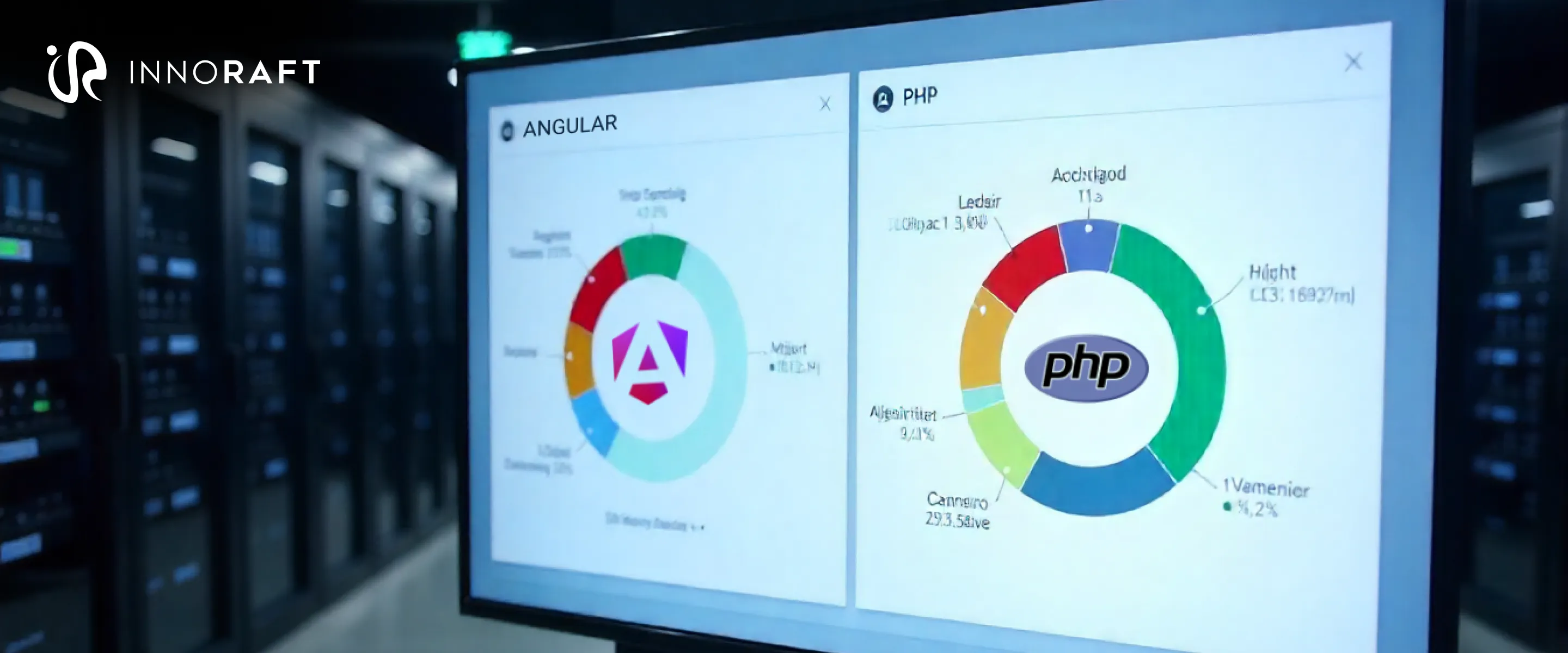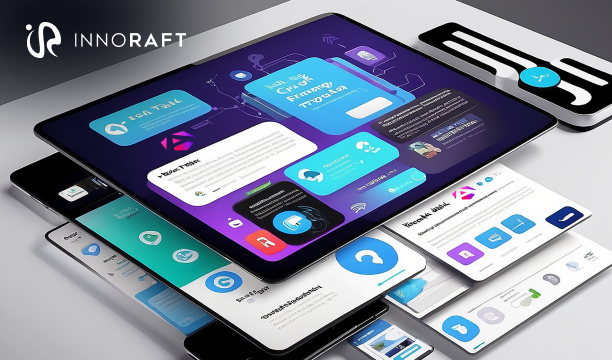Choosing the proper technique for web development is more critical than ever. With the rapid emergence of new equipment and increasing expectations of the user, developers often face a common dilemma: PHP vs Angular - which is a more suitable option? PHP and Angular are like two sides of the same coin, each with its special job. PHP makes it ideal for handling the behind-the-scenes tasks in web development. The Angular framework is impressive at building interactive and dynamic user interfaces, which is what users see and interact with. When comparing Angular vs PHP performance, it's more about what fits your specific project requirements.
Whether you’re starting a new web application or looking for the best language for web development services, this article will help you shape a decision on which one to choose, taking into consideration the performance and the goals you want to achieve.
Let's dive in.
Breaking Down PHP vs Angular for Web Development
Many developers explore the PHP vs. Angular comparison while assessing options for contemporary web applications to decide which solution best suits their application architecture. Despite their widespread usage in web development, they have different functions.
When it comes to developing web applications using PHP, it is fantastic for managing server logic, databases, and user authentication requirements in the backend development. Angular is a powerful client-side framework for building engaging user interfaces, making it a front-end framework of excellence.
When comparing PHP vs Angular for backend development, PHP comes out on top. Having said that, choosing between PHP vs Angular for frontend, Angular wins. It's not about choosing one over the other but looking for how they can interact alongside each other to deliver full-stack, scalable web apps.
Comparing PHP and Angular for Modern Web Development
When deciding which technology to choose for your next project, a thorough PHP vs Angular comparison can assist in understanding their capabilities. Understanding the differences between PHP and Angular for frontend and backend ensures that you select the appropriate stack.
Easy to Learn and Use
PHP: It is simple and great for people just starting on the web. The language is simple and reminiscent of other computer languages, like C and Perl. With PHP being in use for over half a decade, there’s no lack of tutorials, forums, and resources to aid learners at all levels.
Angular: Newbies will find it hard to grasp the component based structure, dependency injection, decorators, and reactive programming in RxJS. To truly master Angular and use it well, it would be suitable for developers to already have a good understanding of TypeScript or modern JavaScript frameworks.
Installation & Configuration
PHP: It is easy to install and operate on a web server and is compatible with Apache or Nginx servers. Most hosting providers support PHP natively, and a local development environment is easy to set up with solutions like XAMPP, MAMP, and Docker.
Angular: To set up Angular, install Node.js and the Angular CLI (Command Line Interface). The CLI makes creating and managing a project easy, but you'll need a little understanding of the command line. By comparison, setting up Angular initially is a bit more complicated, but it promotes a strong front-end environment.
Tech Stack Flexibility
PHP: PHP Web development often uses old and trusty backend structures. PHP integrates well with the LAMP stack (Linux, Apache, MySQL, and PHP), and it is compatible with many relational databases such as MySQL and PostgreSQL. And with the easy to connect (through extension) with NoSQL databases, PHP is a great choice for server-side programming and solid database interaction.
Angular: Web development with Angular is all about building rich, responsive, and high-performance apps. It talks to back-end services via APIs and works with PHP, Node.js, .NET, and Java. It supports RESTful APIs and GraphQL endpoints, allowing developers the freedom in how they plug in data from their back end.
Speed & Efficiency
PHP: It is a server-side script that “runs the script and sends the result (the fully generated HTML containing the form, after being processed by the server) back to the user’s browser.” Its speed depends on the resources available on your server, but it does increase with optimizations (e.g., opcode caching). PHP is well-suited for typical web applications, but may not be ideal for real-time or highly interactive components.
Angular: These apps are written to run in the browser, have fast and responsive interfaces by only updating & re-rendering the parts of the DOM they need to. This client-side rendering reduces the server overhead while improving apparent speed, particularly in single-page applications (SPAs).
Flexibility and Adaptability
PHP: It is frequently utilized for high-traffic websites due to its scalable backend development capabilities. Frameworks like Laravel and Symfony offer tools and features that promote scalability. To keep it efficient, when you write a big PHP application, you need to be clear on architecture and performance optimization.
Angular: Its component-based architecture makes it a great fit for scaling frontend apps. It provides superior lazy loading and code splitting than the built-in Angular module lazy loading. These are some of the features that make Angular a contender for enterprise-grade frontend development.
Security Capabilities
PHP: It comes with security measures to protect your web app against the most common attacks, such as SQL injection, XSS, and CSRF. Only you can prevent bad, insecure code, as with everything, the proper way to deal with security is to pay attention and use secure methods and frameworks, like Laravel/Symfony.
Angular: Angular includes security features of its own, such as automatic sanitization of untrusted data, which can help prevent frontend injection attacks. Nevertheless, we still need to secure the backend to ensure end-to-end application security.
Debugging and Maintenance
PHP: Simple debuggers and methods of error reporting make it convenient even for developers. Popular PHP IDEs and text editors like PhpStorm have built-in debugging functionality. Maintenance-wise, there's Laravel or Symfony, which follow the Model-View-Controller (MVC) architecture.
Angular: It provides rich debugging and profiling features; they are usually integrated directly with modern browser developer tools. Angular CLI supports the testing, error reporting, and flow of development. The good codebase provides maintainability, but you do need an extra load of knowledge about the Angular ecosystem and tooling.
Developer Ecosystem and Community Backing
PHP: There is a rich community around it with mature structure services such as Laravel, Symfony, and CodeIgniter, as well as popular CMS systems such as WordPress and Drupal. It has an active community that caters to detailed support and resources.
Angular: Google backs it and has a thriving community of developers. It comes with a complete package of libraries and tools as well as regular updates, and so it's a superb solution for advanced front-end development.
PHP vs Angular: Which Should You Choose for Your Development Needs?
The objective of comparing PHP vs Angular is to assist you in choosing which is a better fit for your web application development. They are both unique, and contrasting them might seem like comparing an apple to a fruit salad. However, apples can still be included in fruit salads.
Finally, you have to choose between what framework or programming language is really perfect for your project. Angular is the best framework that is used to build large enterprise-grade apps because of its smooth performance, flexibility, maintainability, and use of TypeScript. Developers predominantly use PHP to create small to medium-scale apps. But you can take it as far as you want, even with Angular. It may help develop e-commerce sites and content management systems (CMS).
Conclusion
When it comes to web development using PHP frameworks or web development with Angular, both technologies remain viable solutions. PHP has extensive backend development capabilities, making it perfect for server-side logic, but Angular excels at establishing dynamic, responsive frontend interfaces. The only way to settle the PHP vs Angular debate for your project is to see which development practices they offer. There is no one-size-fits-all solution when it comes to choosing the best language for web development, ultimately.
What you should do is choose based on the intention of your application itself, being designed, scaling, and what your team finds good in terms of development. Still unclear where to go with the PHP vs Angular comparison? Contact us—we're here to help you make a wise decision about your next project.
FAQ
Frequently Asked Questions
Didn’t find what you were looking for here?




